A significant part of my current work involves dealing with thermal printers to print receipts, invoices, item slips etc ..; For those unfamiliar. I’m talking about those usually small cashier side printers that print your receipts when you buy something from a restaurant, or any other shop.
Thermal printers use a universal protocol to send/receive printing commands. This protocol is called ESC/POS. For anyone stumbling on to this post trying to figure-out what the heck is going on with those printers, I feel you. Buffering issues, printer not printing, queuing issues, junk printing, delayed printing, connection loss, data leaks, the list goes on. At some point, I started wondering why does EPSON printers have none of these issues while others did? This led to the curious investigation and reverse engineering of the EPSON TM-m30 printer.
First, Some nuances there are multiple versions of ESC/POS. Not officially. But there are many minor differences between manufacturers making different models of those thermal printers. Each deciding to add custom ESC/POS functions, since the protocol allows that. Some ignoring certain ESC/POS commands. And many having undocumented methods. Some provide their own SDKs like EPSON, who by the way, are the creators of ESC/POS. What makes this hard to discover is that an ESC/POS SDK will usually work and print on all the printers you have. Until it doesn’t for some unknown reason. To fix issues you will probably start adding random delays; and that will work for a while. Then, network speed will break it, print page size could break it, using different OS? will break it. You will try managing the queue yourself. Even that is still not a fix. Everything you end up doing is basically guesswork trying to support a bad protocol that lacks necessary feedback, queuing, and other important functionalities.
EPSON’s Fix
The obvious solution of course, is to have a better protocol/s that communicate back printing status feedback, does error handling/correction, and queuing. This is exactly what EPSON did. A proprietary modified ESC/POS combined with another proprietary protocol for orchestrating printing, discovery, etc …
RE 1
So I went to work. Trying to take the easier path I downloaded EPSON’s JS SDK looking for their discovery method. The discovery method allows the SDK to discover all of EPSON’s thermal printers connected to the network/bluetooth/USB. Since it was something not supported by ESC/POS itself, it must come from a different protocol. Turns out, their JS SDK does not have any of the methods I was looking for. Moving on, I downloaded their Windows SDK and started digging into it using IDA. During that time, I had a background Nmap scan running for all TCP/UDP ports the printer was listening to.
Results:
TCP 9100 which is the normal ESCPOS port
TCP 443 which is the web server for admin and some API
UDP 161 SNMP
UDP 3289 ??
Searching for port 3289 yields results about an ENPC protocol ECSP_SecurityGuideline_v1.1.1.pdf
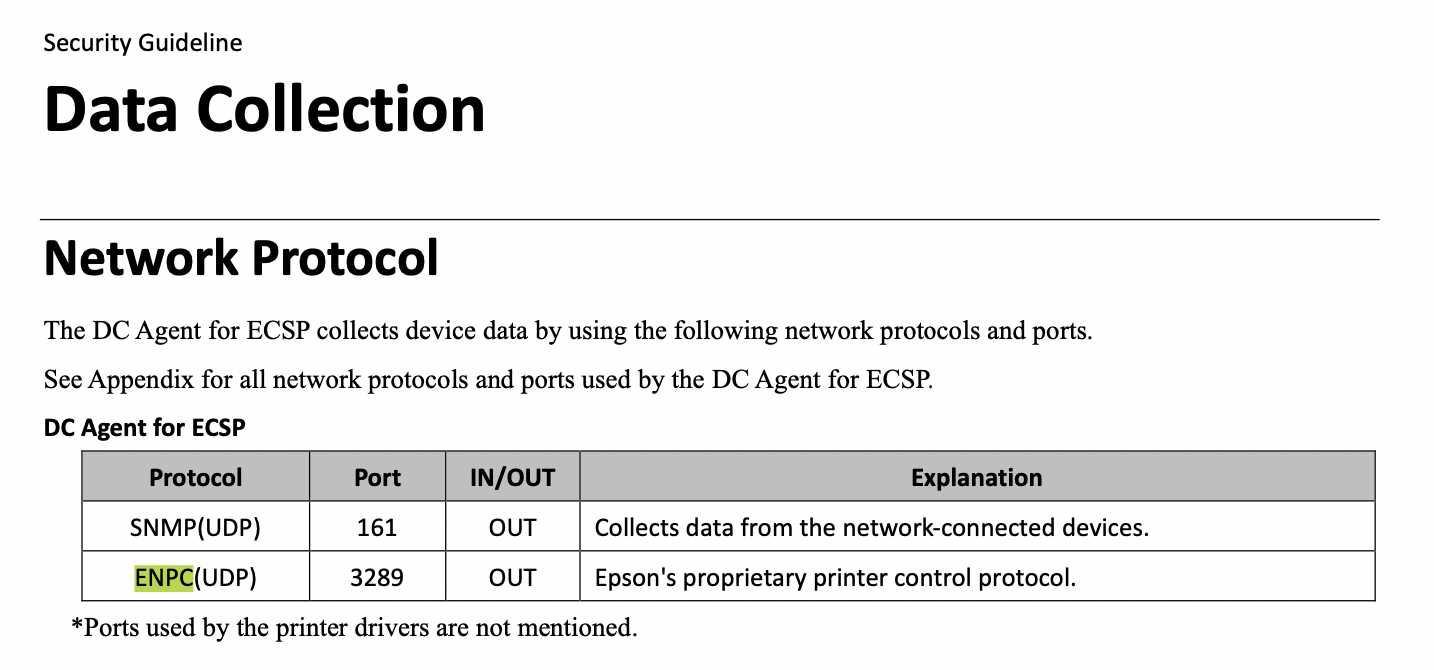
There is also this Stackoverflow question looking for ENPC documentation with a few comments linking to different ENPC references including one 2017 Github repo BlackLotus/epson-stuff of an incomplete attempt at reversing ENPC.
Looking more into the de-compiled SDK. I find the function EpsonIoDiscoveryStart. Following its calls I ended up at the Discovery thread which contained a loop that kept sending a UDP packet to the ENPC port starting with the string ENPCQ as shown below
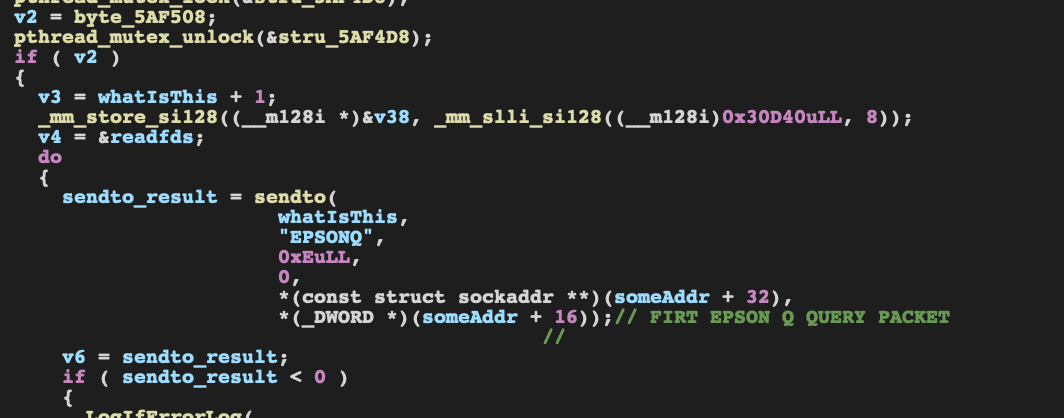
After sending it, it will try to receive a response as shown below.

Using the received response a comparison on the first 6 bytes of the packet will take place and later on the function EpsonIoUpdatePrinterList appears.
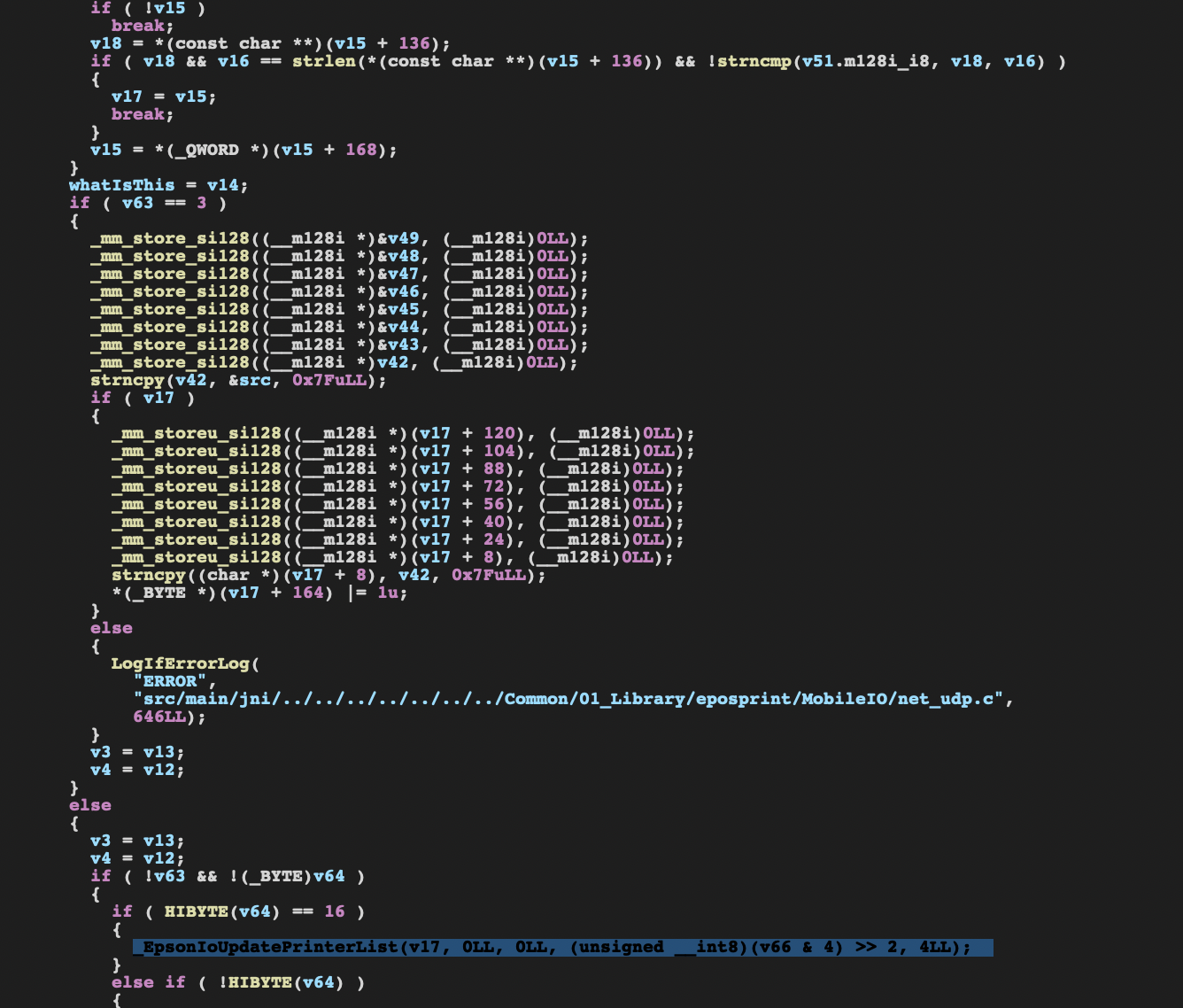
Looking deeper into it, there didn’t seem to be any security mechanism in place. And trying to avoid IDA as much as I could. I decided to consider this enough data gathered to fire up Wireshark and start monitoring what a discovery exchange looks like for ENPC.
 At first glance, the device running the SDK and doing a discovery (IP
At first glance, the device running the SDK and doing a discovery (IP 192.168.1.23) sends a broadcast packet. Then the printer (IP 192.168.1.9) replies. This exchange, alongside other packets in between, kept repeating.
Filtering for important data the result is as shown.
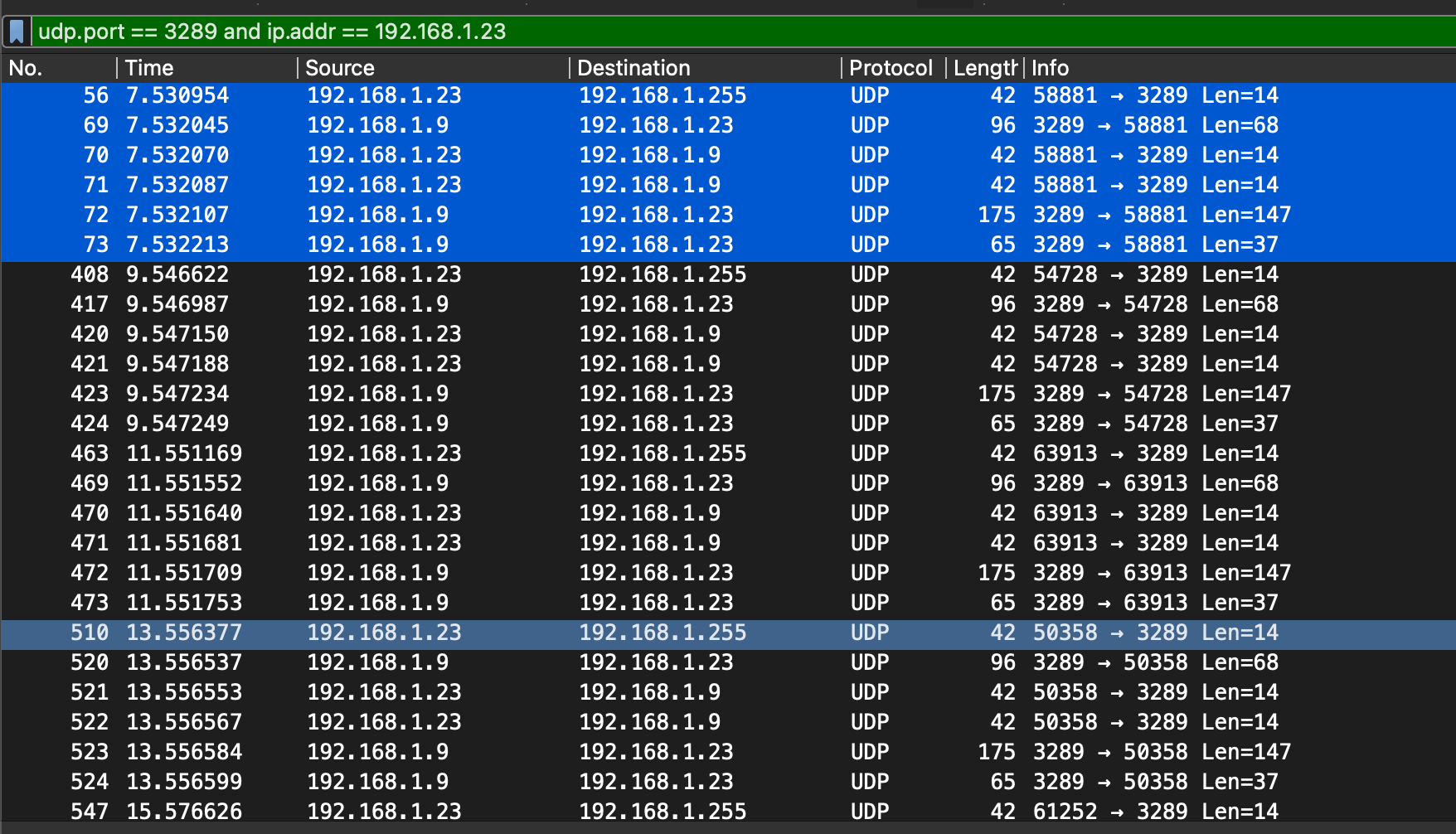
It repeats in a blocks of 6 packets starting with the broadcast packet. This went on even after discovery, which means that the SDK continues to send discovery packets even after the printer is identified.
Digging into the packets I started to notice some patterns.

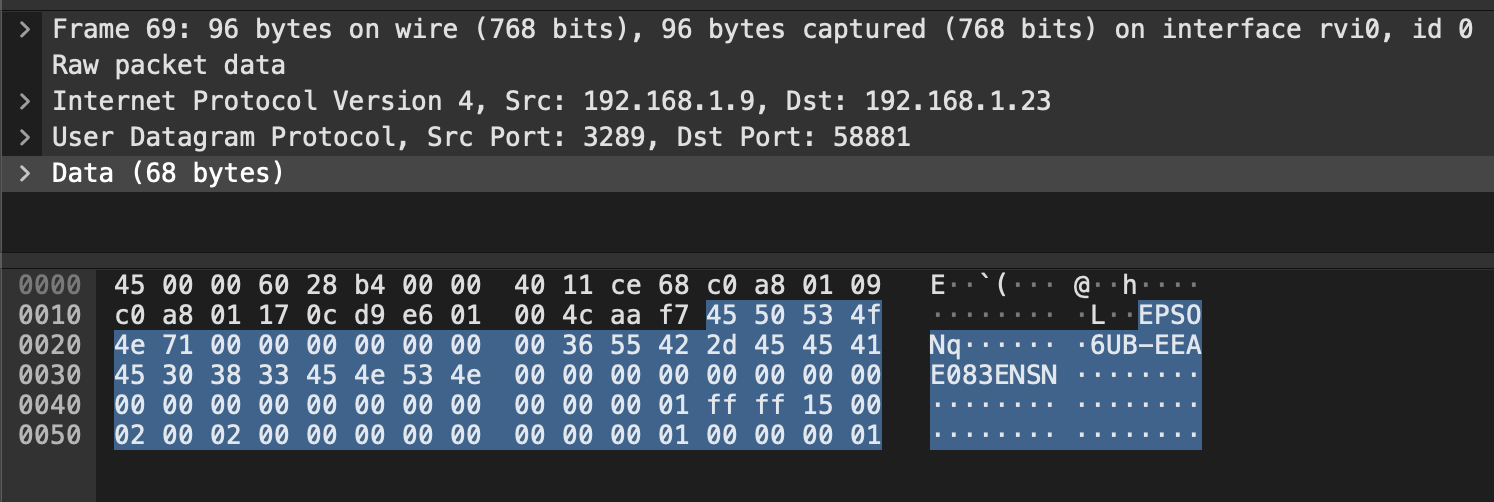
It looks like every message going out from the SDK is starting with the EPSONQ string. The same string I found in IDA. While the response from the printer starts with EPSONq. There are also other packets going out from the SDK starting with the string EPSONC while the response starts with EPSONc.
This looked like how ENPC was differentiating between Q = QUERY and q = QUERY RESPONSE. Also, C = COMMAND and c = COMMAND RESPONSE.
Having figured out the first part of the packet. I started looking into the following bytes. It seemed like the next 4 bytes coming after the EPSON{X}, X being either a query/command message/response, were also consistent between message and response. The bytes after those 4 bytes were also always of consistent size. This was good enough to identify those 4 bytes as the Query or Command function/operation number.
With this in mind. The initial discovery query message had another 4 bytes.
0000 45 50 53 4f 4e 51 03 00 00 00 00 00 00 00 EPSONQ........
EPSONQ = Query message
03 00 00 00 = Function number
00 00 00 00 = ??
Considering this. I started looking into the other packets and noticed that some packets had extra bytes. For those packets, the unidentified 4 bytes were reflecting a number equal the number of the extra bytes. This was clear that the 4 Bytes meant the size of the coming message/response.
Something interesting? The ability to control message/response body length presents a good opportunity to test for buffer overflow. Data leaks, crashes .. I actually only noticed this while writing this post and will probably test it later. EPSON RCE maybe? :P.
Anyway, on to the next packet
0000 45 50 53 4f 4e 71 03 00 00 00 00 00 00 85 00 05 EPSONq..........
0010 01 02 01 54 4d 2d 6d 33 30 00 00 00 00 00 00 00 ...TM-m30.......
0020 00 00 00 00 00 00 00 00 00 00 00 00 00 00 00 00 ................
0030 00 00 00 00 00 00 00 00 00 00 00 00 00 00 00 00 ................
0040 00 00 00 00 00 00 00 00 00 00 00 00 00 00 00 00 ................
0050 00 00 00 00 00 00 00 00 00 00 00 00 00 00 00 00 ................
0060 00 00 00 00 00 00 00 00 00 00 00 00 00 00 00 00 ................
0070 00 00 00 00 00 00 00 00 00 00 00 00 00 00 00 00 ................
0080 00 00 00 00 00 00 00 00 00 00 00 00 00 00 00 00 ................
0090 00 00 00 ...
EPSONq = Query response
03 00 00 00 = Function number
00 00 00 85 = Response size
Extra bytes = the response which had the printer model name and matched the response size
Looking into more packets
0000 45 50 53 4f 4e 71 00 00 00 10 00 00 00 17 01 02 EPSONq..........
0010 00 00 00 00 00 00 04 c0 a8 01 09 ff ff ff 00 c0 ................
0020 a8 01 01 80 7c ....|
EPSONq = Query response
00 00 00 10 = Function number (different function)
...
Now this packet had non-ASCII data. However, if you’ve ever done network stuff in hex you would notice something very familiar. ff ff ff 00 this is equivalent to 255.255.255.0 which happens to be my network netmask.
Converting the other bytes to IPs I got matches for the printer IP, MAC address, and the network gateway IP.
So far, I know that every query/command, for both message and response, follows this structure.
export interface ENPCMessage {
QC: string,
type_hex: string,
func_hex: string,
data_len_hex: string,
data_hex: string
}
Following the same process. through trial and error. I started printing and analyzed the packets. Identifying the most important functions list of ENPC queries/commands as follows
export const ENPC_QUERIES = {
[ENPC_QUERY_FUNCTIONS.DISCOVER_INFO_BROADCAST]: "00000000",
[ENPC_QUERY_FUNCTIONS.DISCOVER_INFO]: "03000010",
[ENPC_QUERY_FUNCTIONS.DISCOVER_DEVICE_NAME]: "03000000",
[ENPC_QUERY_FUNCTIONS.WHO_IS_HOLDING]: "03000017",
[ENPC_QUERY_FUNCTIONS.UNKNOWN_DISCOVER]: "00000010",
};
export const ENPC_COMMANDS = {
[ENPC_COMMAND_FUNCTIONS.UNKNOWN_COMMAND_1]: "03000015",
[ENPC_COMMAND_FUNCTIONS.UNKNOWN_COMMAND_2_CHECK]: "03000016"
};
At this point, I thought about writing a simple spoofer that listens on port 3289 and broadcasts itself as TM-m30 printer. Attempting it with a simple replay of packets did not work, obviously. Because the SDK tries to reach the printer using the provided information from the DISCOVER_INFO query response. This meant that I needed to also build packets with the spoofer device info (ip, and mac address). This was fairly easy with all the important queries identified.
private getQueryResponse(function_hex: string): Uint8Array | undefined {
const func_name = dictContainsValue(ENPC_QUERIES, function_hex);
if (func_name) {
let response: Uint8Array | boolean | undefined = false;
if (func_name == ENPC_QUERY_FUNCTIONS.DISCOVER_INFO_BROADCAST) {
response = this.ENPC_parser.makeENPC(
"q",
ENPC_QUERIES.DISCOVER_INFO_BROADCAST,
"00000036",
`55422d45454145303833454e534e0000000000000000000000000000000000000001ffff15000200${this.mac_address}0000000100000001`
);
}
if (func_name == ENPC_QUERY_FUNCTIONS.DISCOVER_DEVICE_NAME) {
response = this.ENPC_parser.makeENPC(
"q",
ENPC_QUERIES.DISCOVER_DEVICE_NAME,
"00000085",
`0005010201544d2d6d33300000000000000000000000000000000000000000000000000000000000000000000000000000000000000000000000000000000000000000000000000000000000000000000000000000000000000000000000000000000000000000000000000000000000000000000000000000000000000000000000000000`
);
}
if (func_name == ENPC_QUERY_FUNCTIONS.UNKNOWN_DISCOVER) {
response = this.ENPC_parser.makeENPC(
"q",
ENPC_QUERIES.UNKNOWN_DISCOVER,
"00000017",
`01${this.mac_address}0004${this.ip}${this.netmask}${this.gateway}807c`
);
}
if (func_name == ENPC_QUERY_FUNCTIONS.DISCOVER_INFO) {
response = this.ENPC_parser.makeENPC(
"q",
ENPC_QUERIES.DISCOVER_INFO,
"0000000d",
`0e1400000fffffffff39414000`
);
}
if (func_name == ENPC_QUERY_FUNCTIONS.WHO_IS_HOLDING) {
// 00 00 00 00 = No one is holding
// Anything else = ip address for ip holding it
let current_holding_ip = "00000000";
if (this.is_holding) {
current_holding_ip = this.holding_ip;
}
response = this.ENPC_parser.makeENPC(
"q",
ENPC_QUERIES.WHO_IS_HOLDING,
"00000004",
current_holding_ip
);
}
if (response) {
console.log(`\tResponding to query with: ${bytesToHexString(response)}`)
return response;
}
}
console.log("\tTrying to respond to a function not in queries list");
return undefined;
}
Listening on port 3289. Then responding with the above responses; successfully broadcasted a fake TM-m30 printer.
RE 2
With the most important parts of ENPC reversed and emulated. The idea of the protocol was much clearer. It handled discovery of printers. It also checked through the WHO_IS_HOLDING query for who is holding the printer. If the printer responded with the asking device’s ip the SDK will proceed and attempt to print. If it responded with zeros, it will also proceed and connect to the ESC/POS port 9100 and attempt to print. However, if any other IP was holding, the SDK will wait. As soon as a connection is established to port 9100. The holding IP is updated. That is basically what EPSON did to solve holding and prioritizing issues during printing with multiple devices. This is also what all other printers lacked. Now, there are still other issues with ESC/POS that this simple ENPC holding check is not enough to fix.
Next in line was attempting to print using the emulated printer and watching the ESC/POS data flow. However. the TM-m30 had other tricks built in into its ESC/POS allowing it to be more reliable and preventing a simple replay of packets from working.
Starting with regular status messages from the printer to the SDK through ESC/POS. Also, better queuing.
I was able to identify many of the commands through the ESC/POS Spec documentation. But, many of the commands sent from the printer were custom to the EPSON printer.
The ESC/POS printing process always started with a DLE DOT n command asking for real time transmission of printer status. (Which many printers did not implement!)
 .
.
The SDK will also attempt to periodically enable Automatic Status Back (ASB) expecting a response of 1400000f.
There are many other ESC/POS exchanges that were missing from other printers. I decided to skim over those and just replay them back without understanding.
if (hex_data == "100401") {
socket.write(hexStringToBytes("16") as Uint8Array);
}
if (hex_data.includes("1d61ff")) {
socket.write(hexStringToBytes("1400000f") as Uint8Array);
}
if (hex_data == "1b3d011d2845020006031d496e1b3d011d28450200060b") {
socket.write(hexStringToBytes("3727331f3600") as Uint8Array);
socket.write(hexStringToBytes("3d6e00372731311f3000") as Uint8Array);
}
if (hex_data == "10140801031401060208") {
socket.write(hexStringToBytes("372500") as Uint8Array);
}
if (hex_data == "101406040001031401060208") {
socket.write(hexStringToBytes("375c3000") as Uint8Array);
}
Replaying packets was almost enough to get the ESC/POS printing process completed. However, one critical part was missing. an EPSON modified ESC/POS print-job queuing functionality! (The most important missing future causing issues in the other printers). As you can see below, at the end of EPSON’s ESC/POS printing commands, it sends a QR Model Select command. That’s weird, I wasn’t printing any QR codes. Also, the QR model function and other values did not match the ESC/POS spec.
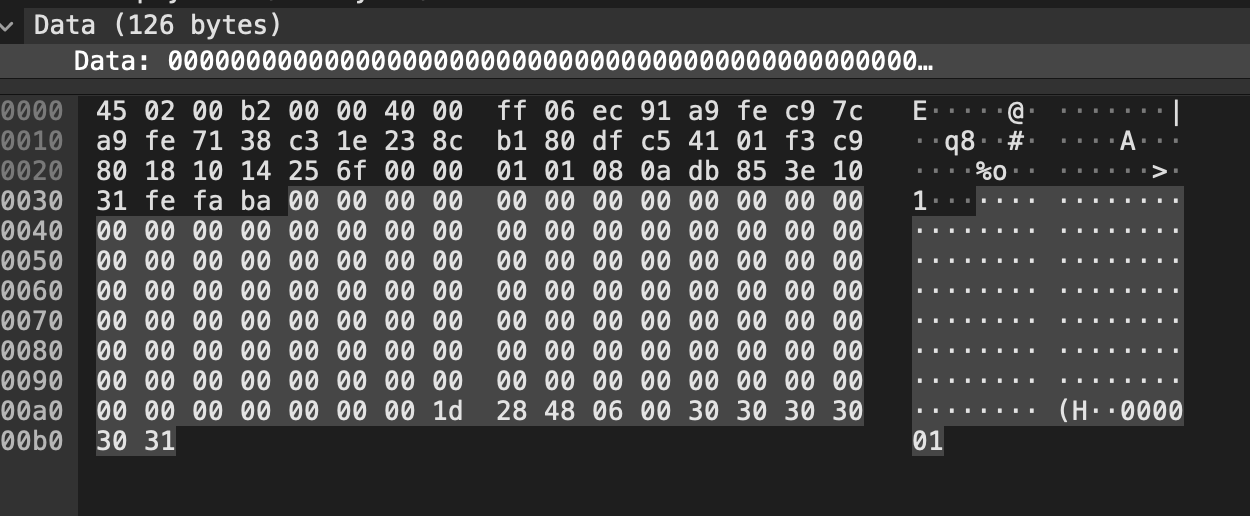
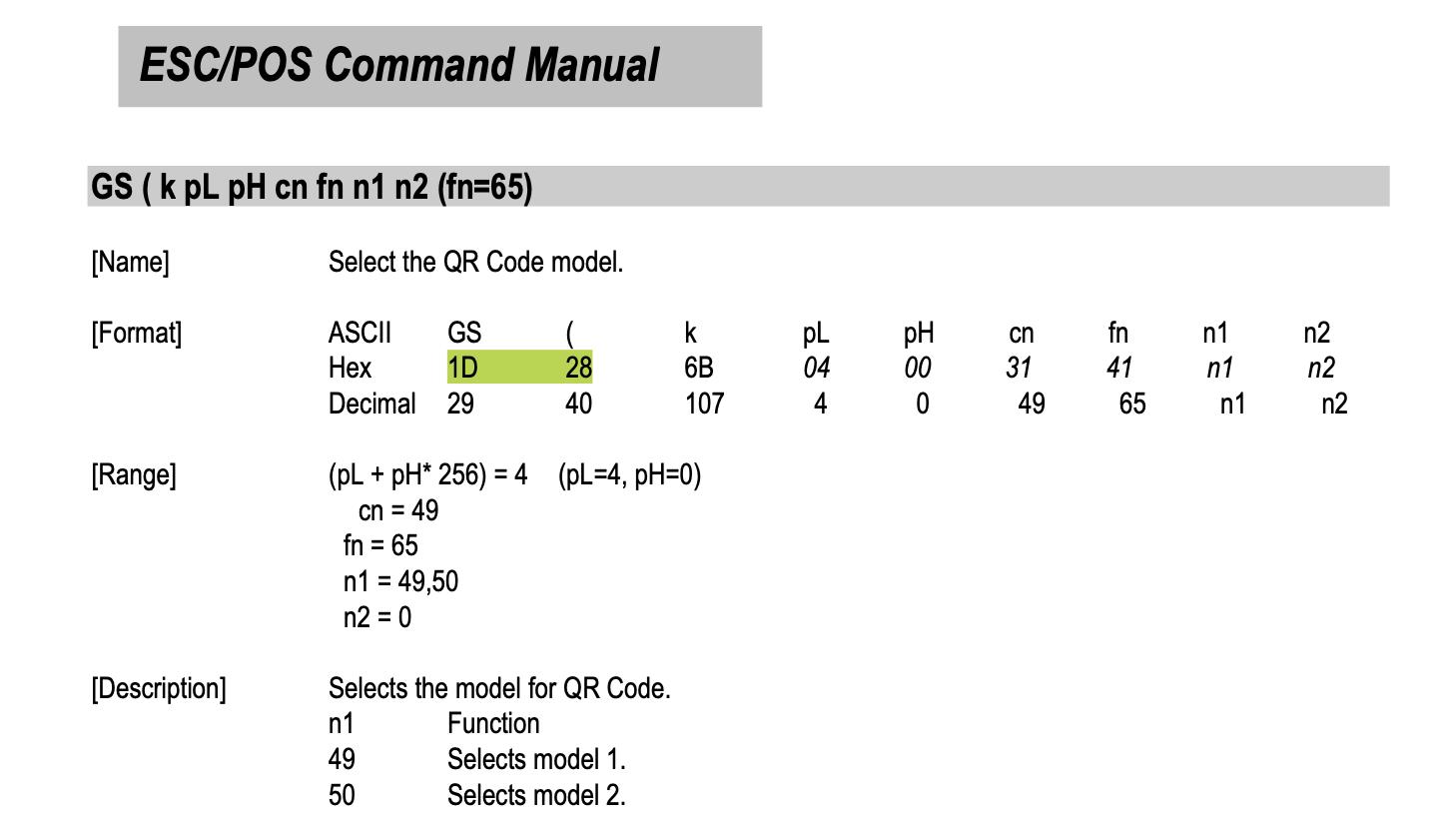
The printer was responding with the same ASCII string 000001 appearing at the end in the QR Model select command.

This ascii string changes to 000002 then 000003 with each print. Making it clear that this command is used to queue printing jobs and report their status back done to the SDK. With the last missing part understood. I started handling the command.
if(hex_data.includes("1d28480600")) {
// Sets print job number and starting printing the buffer
// Get Counter for current print-job
const counter = hex_data.split("1d28480600")[1].slice(4);
instance.ESCPOSLastPrintJobCounter = counter;
socket.write(hexStringToBytes("1400000f") as Uint8Array);
if (instance.ESCPOSLastConnectionSocket) {
// Send that ESCPOS printing-job is done (custom EPSON message)
socket.write(hexStringToBytes(`3722${instance.ESCPOSLastPrintJobCounter}00`) as Uint8Array);
instance.ESCPOSLastConnectionSocket.destroy();
instance.is_holding = false;
instance.holding_ip = "00000000";
instance.ESCPOSLastConnectionSocket = undefined;
instance.ESCPOSLastPrintJobCounter = undefined;
// Get image from last stored ESCPOS data
generate_merged_bitmap_png(escpos_data_stored, [0]).then( (png_path) => {
if (png_path) {
instance.onReceipt(png_path);
}
});
escpos_data_stored = "";
}
}
With all that done. Now I can broadcast a TM-m30 printer. Connect to it, and get the ESC/POS data from print-jobs.
Extra ?
To have more fun I decide to fire up Square POS. Connect to the printer and attempt to get the printer receipt. However, when I found no encoded text in the ESC/POS print data. I figured that Square was sending bitmap images instead of text. How to extract that? with some borrowed help from escpos-tools I wrote the following image processor which extracts the graphics data. Merges the bitmaps (since Square sends multiple) and converts it to a PNG using ffmpeg.
import { Buffer } from "buffer";
import { FFmpegKit, ReturnCode } from 'ffmpeg-kit-react-native';
import RNFS from "react-native-fs";
interface BitmapImage {
height: number,
width: number,
bitmap: Buffer
}
// GS = 0x1D
// ? = 0x38
// GraphicsLargeDataCmd = 0x4C
const ESCPOS_GRAPHICS_LARGE_DATA_CMD = "1d384c";
/*
command datasize a1 a2 x1 x2 y1 y2 data(len = datasize)
1d384c c2 1a 00 00 30 70 00 00 00 00 00 00 00 00 0000000000000000...
*/
const parseGraphicsDataBlocks = (graphics_hexdata_blocks: string[]): (BitmapImage | undefined)[] => {
return graphics_hexdata_blocks.map((graphics_hexdata_block: string, index: number) => {
let workable_graphics_hexdata_block = graphics_hexdata_block;
// Extract datasize indicators (4 bytes)
let datasize_indicators = workable_graphics_hexdata_block.slice(0, 4 * 2).match(/.{1,2}/g) as any;
workable_graphics_hexdata_block = workable_graphics_hexdata_block.slice(4*2);
datasize_indicators = datasize_indicators?.map( (n: string) => parseInt(n, 16)) as number[];
// Extract a1 = ?, a2 = 0x70 = StoreRasterFmtDataToPrintBufferGraphicsSubCmd (2 bytes)
const [a1, a2] = workable_graphics_hexdata_block.slice(0, 2 * 2).match(/.{1,2}/g) as any;
workable_graphics_hexdata_block = workable_graphics_hexdata_block.slice(2*2);
// Pass over filler (4 bytes)
workable_graphics_hexdata_block = workable_graphics_hexdata_block.slice(4*2);
// Extract dimensions_indicators
let dimensions_indicators = workable_graphics_hexdata_block.slice(0, 4 * 2).match(/.{1,2}/g) as any;
workable_graphics_hexdata_block = workable_graphics_hexdata_block.slice(4*2);
dimensions_indicators = dimensions_indicators.map( (n: string) => parseInt(n, 16)) as number[];
// Confirm function is StoreRasterFmtDataToPrintBufferGraphicsSubCmd
if (a2 != "70") return;
// Calculate datasize (Not used)
const [d1, d2, d3, d4] = datasize_indicators;
let datasize = (d1 + (d2 * 256) + (d3 * 65536) + (d4 * 16777216)) - 2;
// Calculate width and height
const [x1, x2, y1, y2] = dimensions_indicators;
const width = x1 + (x2 * 256);
const height = y1 + (y2 * 256);
// Extract data
let graphics_data = workable_graphics_hexdata_block.slice(0, ((width * (height)) / 8) * 2);
// Convert to buffer
const bitmap = Buffer.from(graphics_data, "hex");
// Logging
console.log(`\n[BLOCK #${index}]`);
console.log(`\tDatasize indicators (d1, d2, d3, d4): ${datasize_indicators}`);
console.log(`\tDatasize: ${datasize}`);
console.log(`\tDimensions indicators (x1, x2, y1, y2): ${dimensions_indicators}`);
console.log(`\tDimensions (w, h): (${width}, ${height})`);
// Should be same as datasize
console.log(`\tBitmap data length: ${bitmap.length}`);
return {
width: width,
height: height,
bitmap: bitmap
}
});
}
const getESCPOSGraphics = (hexdata: string): (BitmapImage | undefined)[] | undefined => {
// Look for graphics cmds
const graphicsLargeDataBlocks = hexdata.split(ESCPOS_GRAPHICS_LARGE_DATA_CMD);
if (!graphicsLargeDataBlocks.length) return;
// removes first (useless) item in array
graphicsLargeDataBlocks.shift();
const bitmap_images = parseGraphicsDataBlocks(graphicsLargeDataBlocks);
return bitmap_images;
}
const bitmapImageToPBM = (bitmap_image: BitmapImage): Buffer => {
const header = Buffer.from("P4\n" + bitmap_image.width + " " + bitmap_image.height + "\n");
const buffers = [header, bitmap_image.bitmap];
return Buffer.concat(buffers);
}
const mergeBitmapImages = (bitmap_images: BitmapImage[]): BitmapImage => {
// Using first width
return {
width: bitmap_images[0].width,
height: bitmap_images.reduce((p, current) => p + current.height, 0),
bitmap: Buffer.concat(bitmap_images.map( bitmap_image => bitmap_image.bitmap))
}
}
export const generate_merged_bitmap_png = async (hex_escpos_data: string, skip_indecies: number[]): Promise<string | undefined> => {
return new Promise<string | undefined>( async (resolve, reject) => {
let bitmap_images = getESCPOSGraphics(hex_escpos_data);
if (bitmap_images) {
bitmap_images = bitmap_images.filter( (_, index) => !skip_indecies.includes(index) );
const bitmap_images_merged = mergeBitmapImages(bitmap_images as BitmapImage[]);
const pbm_image = bitmapImageToPBM(bitmap_images_merged);
const pbm_path = RNFS.DocumentDirectoryPath + `/escpos-print.pbm`;
const png_path = RNFS.DocumentDirectoryPath + `/escpos-print.png`;
let buf = '';
pbm_image.map((v, i, a) => {
buf += String.fromCharCode(v);
return 0;
})
RNFS.writeFile(pbm_path, buf, 'ascii').then((success) => {
console.log('FILE WRITTEN! to', pbm_path);
FFmpegKit.execute(`-y -i ${pbm_path} ${png_path}`).then(async (session) => {
const returnCode = await session.getReturnCode();
if (ReturnCode.isSuccess(returnCode)) {
// SUCCESS
console.log('FILE WRITTEN! to', png_path);
resolve(png_path);
} else {
// ERROR
reject();
}
});
}).catch((error) => {
console.log(error);
reject();
})
}
});
}
I made the project using react-native, and typescript in order to broadcast the printer using my mobile device, then get the printed image in view for fun. This was the end result

Conclusion
Other than having fun, and hopefully this post being helpful to someone. The project was of no help in discovering a solution to other printers. There are in my opinion no solutions, other than having a printer run a custom firmware, using an EPSON printer, or any other printer that has a custom firmware and SDKs. There is a reason why many POS systems only support a specific set of printers.